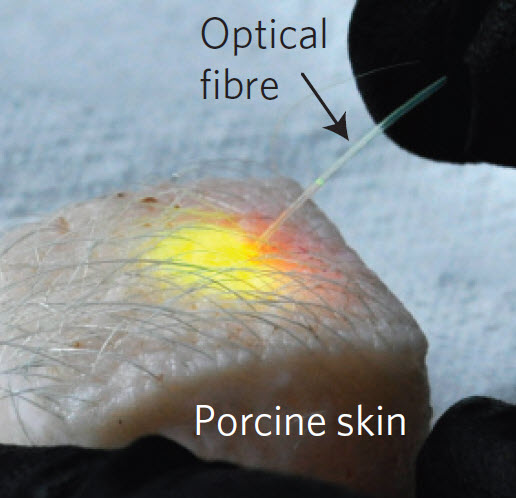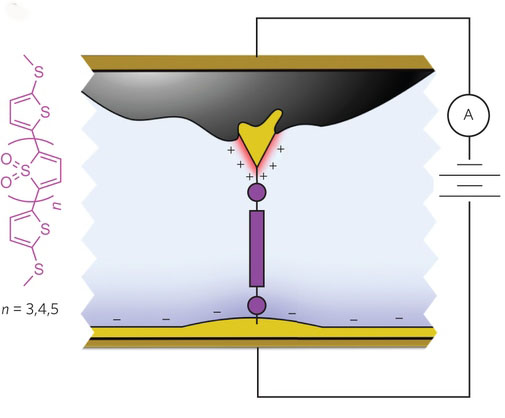
The plan will drastically reduce America’s reliance on coal-fired power plants, the country’s biggest source of carbon emissions.
The post Obama’s Climate Change Plan Is Actually About Public Health appeared first on WIRED.

Science and reality

The plan will drastically reduce America’s reliance on coal-fired power plants, the country’s biggest source of carbon emissions.
The post Obama’s Climate Change Plan Is Actually About Public Health appeared first on WIRED.

Massachusetts General Hospital investigators have induced subcutaneous fat cells in a piece of skin from a pig to emit laser light in response to energy delivered through an optical fiber (credit: Matjaž Humar and Seok Hyun Yun/Nature Photonics)
Imagine being able to label a trillion cells in the body to detect what’s going on in each individual cell.
That’s the eventual goal of a Massachusetts General Hospital (MGH) study to allow individual cells to produce laser light. The wavelengths of light emitted by these intracellular microlasers differ based on factors such as the size, shape, and composition of each microlaser, allowing precise labeling of individual cells.
“The fluorescent dyes currently used for research and for medical diagnosis are limited because they emit a very broad spectrum of light,” explains Seok Hyun Yun, PhD, of the Wellman Center for Photomedicine at MGH, corresponding author of the report. “As a result, only a handful of dyes can be used at a time, since their spectral signatures would overlap.”

(Left) Bright-field image of a HeLa cell containing a polystyrene fluorescent bead. (Right) False-color image of the cell. (scale bars: 10 micrometers) (credit: Matjaž Humar and Seok Hyun Yun/Nature Photonics)
Lead author Matjaž Humar, PhD, also of the Wellman Center, adds, “The narrow-band spectrum of light emitted by these intracellular lasers would allow us to label thousands — in principle, up to a trillion — of cells individually [the estimated number of cells in the human body], and the very specific wavelengths emitted by these microlasers also would allow us to measure small changes happening within a cell with much greater sensitivity than is possible with broadband fluorescence.”
The trick is to use solid plastic fluorescent microbeads, which are readily taken up into cells, each with a unique signature spectrum based on the size and number of beads within a cell and the fluorescent dye used.
“One immediate application of these intracellular lasers could be basic studies, such as understanding how cells move and respond to external forces,” says Yun, an associate professor of Dermatology at Harvard Medical School.
“Another challenging step will be figuring out how to use biologically generated energy from mechanical movement or a biochemical reaction to pump a cellular laser in a living body. Cells are smart machines, and we are interested in exploiting their amazing capabilities by developing smart-cell lasers that might be able to find diseases and fire light at them on their own.
“We can envision lasers completely made out of materials that are safe for use within the human body, which could enable remote sensing within the body or be used in laser-light therapies.”
The researchers’ report has received Advance Online Publication in Nature Photonics.
Abstract of Intracellular microlasers
Optical microresonators, which confine light within a small cavity, are widely exploited for various applications ranging from the realization of lasers and nonlinear devices to biochemical and optomechanical sensing. Here we use microresonators and suitable optical gain materials inside biological cells to demonstrate various optical functions in vitro including lasing. We explore two distinct types of microresonator—soft and hard—that support whispering-gallery modes. Soft droplets formed by injecting oil or using natural lipid droplets support intracellular laser action. The laser spectra from oil-droplet microlasers can chart cytoplasmic internal stress (∼500 pN μm–2) and its dynamic fluctuations at a sensitivity of 20 pN μm–2 (20 Pa). In a second form, whispering-gallery modes within phagocytized polystyrene beads of different sizes enable individual tagging of thousands of cells easily and, in principle, a much larger number by multiplexing with different dyes.

Titan, former world’s fastest supercomputer (credit: Oak Ridge National Laboratory)
President Obama has signed an executive order authorizing the National Strategic Computing Initiative (NSCI), with the goal of creating the world’s fastest supercomputers. The NSCI is charged with building the world’s first-ever exascale* (1,000-petaflops) computer — 30 times faster than today’s fastest supercomputer.
The order mandates:
Regaining number 1
In 2013, the U.S lost its position as having the world’s fastest supercomputer — Titan, with 17.59 petaflop/s (quadrillions of calculations per second) Rmax on the Linpack benchmark — to China with its Tianhe-2, a supercomputer with 33.86 petaflop/s, developed by China’s National University of Defense Technology, according to the TOP500 lists of the world’s most powerful supercomputers.
There are three lead agencies for the NSCI: the Department of Energy (DOE), the Department of Defense (DOD), and the National Science Foundation (NSF). There are also two foundational research and development agencies for the NSCI: the Intelligence Advanced Research Projects Activity (IARPA) and the National Institute of Standards and Technology (NIST).
* Exa: 1018; peta: 1015

Researchers from Berkeley Lab and Columbia University have created the world’s highest-performance single-molecule diode, using a combination of gold electrodes (yellow) and a “TDO” molecule (purple, with molecular structure on the left) in propylene carbonate, an ionic solution (light blue). The circuit symbols on the right represent a battery and an ammeter (A) to measure current flow. (credit: Brian Capozzi et al./Nature Nanotechnology)
A team of researchers from Berkeley Lab and Columbia University has created “the world’s highest-performance single-molecule diode,” using a combination of gold electrodes and an ionic solution.
The diode’s rectification ratio (ratio of forward to reverse current at fixed voltage) is in excess of 200, “a record for single-molecule devices,” says Jeff Neaton, Director of the Molecular Foundry, a senior faculty scientist with Berkeley Lab’s Materials Sciences Division and the Department of Physics at the University of California Berkeley and a member of the Kavli Energy Nanoscience Institute at Berkeley (Kavli ENSI).
Ultimate electronic miniaturization
Single-molecule devices represent the ultimate limit in electronic miniaturization, the researchers say. In 1974, molecular electronics pioneers Mark Ratner and Arieh Aviram theorized that an asymmetric molecule could act as a diode, or rectifier (a one-way conductor of electric current). Diodes have a number of uses in electronic devices.
Since then, development of functional single-molecule electronic devices has been a major pursuit, with diodes — one of the most widely used electronic components — at the top of the list.

A p–n junction (credit: Wikimedia Commons)
A typical current diode consists of a silicon p-n junction between a pair of electrodes (anode and cathode) that serves as the “valve” of an electrical circuit, directing the flow of current by allowing it to pass through in only one “forward” direction. The asymmetry of a p-n junction presents the electrons with an “on/off” transport environment (p–n junctions are elementary “building blocks” of most semiconductor electronic devices such as transistors, solar cells, LEDs, and integrated circuits).
Scientists have previously fashioned single-molecule diodes either through chemical synthesis of special asymmetric molecules (analogous to a p-n junction) or using symmetric molecules with different metals as the two electrodes. However, the resulting asymmetric junctions yielded low rectification ratios and low forward current. Neaton and his colleagues at Columbia University have now discovered a way to address both deficiencies.*
The Berkeley Lab-Columbia University team believes their new approach to a single-molecule diode provides a general route for tuning nonlinear nanoscale-device phenomena that could be applied to systems beyond single-molecule junctions and two-terminal devices, such as ionic liquid gating and two-dimensional materials.
The research is described in Nature Nanotechnology.
* “Electron flow at molecular length-scales is dominated by quantum tunneling,” Neaton explains. “The efficiency of the tunneling process depends intimately on the degree of alignment of the molecule’s discrete energy levels with the electrode’s continuous spectrum. In a molecular rectifier, this alignment is enhanced for positive voltage, leading to an increase in tunneling, and is reduced for negative voltage. At the Molecular Foundry we developed an approach to accurately compute energy-level alignment and tunneling probability in single-molecule junctions. This method allowed myself and Zhenfei Liu to understand the diode behavior quantitatively.”
In collaboration with Columbia University’s Latha Venkataraman and Luis Campos and their respective research groups, Neaton and Liu fabricated a high-performing rectifier from junctions made of symmetric molecules with molecular resonance in nearly perfect alignment with the Fermi electron energy levels of the gold electrodes. Symmetry was broken by a substantial difference in the size of the area on each gold electrode that was exposed to the ionic solution. Owing to the asymmetric electrode area, the ionic solution, and the junction energy level alignment, a positive voltage increases current substantially; a negative voltage suppresses it equally significantly.
“The ionic solution, combined with the asymmetry in electrode areas, allows us to control the junction’s electrostatic environment simply by changing the bias polarity,” Neaton says. “In addition to breaking symmetry, double layers formed by ionic solution also generate dipole differences at the two electrodes, which is the underlying reason behind the asymmetric shift of molecular resonance. The Columbia group’s experiments showed that with the same molecule and electrode setup, a non-ionic solution yields no rectification at all.”
Abstract of Single-molecule diodes with high rectification ratios through environmental control
Molecular electronics aims to miniaturize electronic devices by using subnanometre-scale active components. A single-molecule diode, a circuit element that directs current flow, was first proposed more than 40 years ago and consisted of an asymmetric molecule comprising a donor–bridge–acceptor architecture to mimic a semiconductor p–n junction. Several single-molecule diodes have since been realized in junctions featuring asymmetric molecular backbones, molecule–electrode linkers or electrode materials. Despite these advances, molecular diodes have had limited potential for applications due to their low conductance, low rectification ratios, extreme sensitivity to the junction structure and high operating voltages. Here, we demonstrate a powerful approach to induce current rectification in symmetric single-molecule junctions using two electrodes of the same metal, but breaking symmetry by exposing considerably different electrode areas to an ionic solution. This allows us to control the junction’s electrostatic environment in an asymmetric fashion by simply changing the bias polarity. With this method, we reliably and reproducibly achieve rectification ratios in excess of 200 at voltages as low as 370 mV using a symmetric oligomer of thiophene-1,1-dioxide. By taking advantage of the changes in the junction environment induced by the presence of an ionic solution, this method provides a general route for tuning nonlinear nanoscale device phenomena, which could potentially be applied in systems beyond single-molecule junctions.
The Millennium Project released today its annual “2015-16 State of the Future” report, listing global trends on 28 indicators of progress and regress, new insights into 15 Global Challenges, and impacts of artificial intelligence, synthetic biology, nanotechnology and other advanced technologies on employment over the next 35 years.
“Another 2.3 billion people are expected to be added to the planet in just 35 years,” the report notes. “By
2050, new systems for food, water, energy, education, health, economics, and global governance will be needed to prevent massive and complex human and environmental disasters.”
This “World Report Card” may have “more data, information, intelligence, and wisdom about the future of the world than has ever been assembled in one report,” says Jerome Glenn, CEO of The Millennium Project and lead author of the report.
The 300-page report distills research from UN organizations, national governments, think tanks, and thought leaders around the world, with more than 50 charts and graphs. A free 14-page executive summary is available in English and five other languages.
The key findings include:
The Millennium Project is a global participatory think tank connecting 56 Nodes around the world that identify important long-range challenges and strategies and initiate and conduct foresight studies, workshops, symposiums, and advanced training. Its mission is to improve thinking about the future and make it available through a variety of media for feedback to accumulate wisdom about the future for better decisions today.
In addition to the annual “State of the Future” reports, the Millennium Project produces thew “Futures Research Methodology” series, the Global Futures Intelligence System (GFIS), and special studies. More than 4,500 futurists, scholars, business planners, and policy makers who work for international organizations, governments, corporations, NGOs, and universities have participated in The Millennium Project’s research since its inception in 1992.

Scientists at Harvard are studying taste buds in action by beaming lasers onto mouse tongues.
The post Sucking on Mouse Tongues to Understand How Taste Buds Work appeared first on WIRED.

Americans inherited a legal system shaped by history, not by science.
The post America’s Justice System Sure Doesn’t Know Much Science appeared first on WIRED.

With snowpacks at zero percent and reservoirs looking more like puddles, engineers in San Diego are preparing to hook up a new $1 billion desalinization plant.
The post One Way to Fight California’s Drought: Desalting the Ocean appeared first on WIRED.